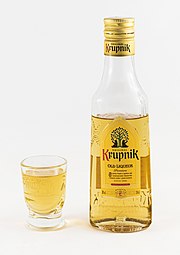Krupnik
Krupnik is a traditional honey nalewka that is especially popular in Poland and Lithuania . It consists of alcohol ( neutral alcohol , vodka or corn brandy ), water, sugar and / or honey and is sweetened and flavored with up to 50 different herbs. If the alcohol content is above 37.5% and only vodka is used as the alcoholic base, Krupnik can also be sold as "honey vodka".
Krupnik is drunk cold as well as hot and even mixed with beer and is also mixed in cocktails , for example in Krupnik Sour .
Word origin and history
The name is derived from the old Slavic word krupa (barley grain). Known in Poland and Lithuania since at least the 16th century, Krupnik was soon a popular drink , especially with the Szlachta of the Polish-Lithuanian Union . There are numerous recipes in diaries this time.
Krupnik is also the Polish name for a barley soup (pearl barley soup ).
Other honey liqueurs
The drink is also known as an East Prussian specialty under the name Bärenfang and goes back to the 15th century, when the art of distillation probably developed in Eastern Europe. The early home-made liqueurs were called "Meschkinnes" in some regions of East Prussia, Mazury and Lithuania , derived from the Lithuanian word "meska" (bear), while in Russia they were called "Okhotnichya" (hunter vodka).
Statutory Regulations
“Krupnik” is not a protected designation of origin under EU spirits law; "Honey vodka" or "honey liqueur" are also not defined in more detail in the EU Spirits Regulation, so the general rules and classifications apply.
In this respect, the classification as “honey vodka”, which is often mentioned in the literature, is somewhat misleading, as the regulation defines vodka as a high-proof spirit that is largely tasteless (and in this respect resembles neutral alcohol ). Since 2008, however, the Spirits Ordinance has also recognized “flavored vodka”, which allows sugar (or sweetening with other sweeteners such as honey) and subsequent flavoring. In addition to “Flavored Vodka”, it is also possible to use the predominant aroma in connection with “Vodka”, for example “Honey Vodka”. However, this assumes that the alcoholic basis of the product consists exclusively of vodka and that a minimum alcohol content of 37.5% is achieved.
Alternatively, Krupnik is also offered as a liqueur or "honey liqueur". The alcoholic base for liqueur can, but does not have to be, a distillate (like vodka or corn brandy), it can also be made from neutral alcohol and theoretically from any other spirit within the meaning of the regulation. The minimum alcohol content of liqueurs, like spirits in general, is only 15% vol., But they must contain at least 100 g of sugar per liter or a corresponding content of other sweeteners.
If the requirements for several sales names are met at the same time, the manufacturer can choose from them, that is, a correspondingly high-percentage “honey liqueur” based on vodka could also be sold as “flavored vodka”; conversely, a “honey vodka” that is sufficiently sweet can be called “liqueur”. If a product does not meet any of the above-mentioned classifications, it is simply referred to as " spirit ".
Brands and products
The best-known brand is Old Krupnik with 38% vol. and the trade name “honey liqueur”, which is produced by the Destylarnia Sobieski SA distillery in Starogard Gdański . Ordinary vodka is also offered under the name Krupnik. Like Belvedere , Sobieski belongs to the multinational luxury conglomerate Moët Hennessy Louis Vuitton . The recipe is said to go back to a recipe from the 18th century, the product contains, among other things, natural honey and extracts from roots and leaves of various plants.
Web links
Individual evidence
- ↑ a b c d André Dominé : The ultimate bar book. The world of spirits and cocktails . hfullmann publishers (Tandem Verlag), Potsdam 2008, ISBN 978-3-8331-4802-6 , p. 637.
- ↑ a b c d Regulation (EC) No. 110/2008 , accessed on August 25, 2015 ("EU Spirits Regulation"). Vodka: Appendix II, No. 15; Flavored vodka: Appendix II No. 30, liqueur: Appendix II No. 31.
